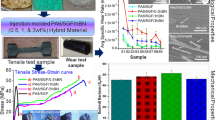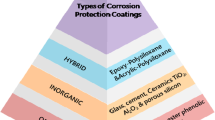Abstract
In this study, nickel phyllosilicate was synthesized based on molybdenum disulfide (MoS2@NiPS) by the sol-gel method, and then MoS2@NiPS was used to prepare epoxy composites. The thermal stability, flame retardancy, and frictional performances of epoxy composites were studied. With the addition of 3 wt% MoS2@NiPS, the epoxy composite increased the limiting oxygen index from 23.8% to 26.1% and reduced the vertical burning time from 166 s for epoxy resin to 35 s. The residual char of the epoxy composite increased from 11.8 to 20.2 wt%. MoS2@NiPS promoted the graphitization of the residual char, and facilitated the formation of a dense and continuous char layer, thereby improving the fire safety of epoxy resin. The epoxy composite with 3 wt% MoS2@NiPS had excellent wear resistance property with a wear rate of 2.19 × 10−5 mm3·N−1·m−1, which was 68.8% lower than that of epoxy resin. This study presented a practical approach to improve the frictional and fire resistance of epoxy composites.

Similar content being viewed by others
References
Pourchet S, Sonnier R, Ben-Abdelkader M, Gaillard Y, Ruiz Q, Placet V, Plasseraud L, Boni G. New reactive isoeugenol based phosphate flame retardant: toward green epoxy resins. ACS Sustainable Chemistry & Engineering, 2019, 7(16): 14074–14088
Tang G, Zhao R Q, Deng D, Yang Y D, Chen D P, Zhang B, Liu X L, Liu X Y. Self-extinguishing and transparent epoxy resin modified by a phosphine oxide-containing bio-based derivative. Frontiers of Chemical Science and Engineering, 2021, 15(5): 1269–1280
Wu T, Yang F H, Tao J, Zhao H B, Yu C B, Rao W H. Design of P-decorated POSS towards flame-retardant, mechanically-strong, tough and transparent epoxy resins. Journal of Colloid and Interface Science, 2023, 640: 864–876
Wetzel B, Haupert F, Qiu Zhang M. Epoxy nanocomposites with high mechanical and tribological performance. Composites Science and Technology, 2003, 63(14): 2055–2067
Chang L, Zhang Z, Ye L, Friedrich K. Tribological properties of epoxy nanocomposites: III. Characteristics of transfer films. Wear, 2007, 262(5–6): 699–706
Morgan A B. The future of flame retardant polymers—unmet needs and likely new approaches. Polymer Reviews (Philadelphia, Pa.), 2019, 59(1): 25–54
Carosio F, Fina A. Three organic/inorganic nanolayers on flexible foam allow retaining superior flame retardancy performance upon mechanical compression cycles. Frontiers in Materials, 2019, 6: 20
Pan Y, Liu L X, Cai W, Hu Y, Jiang S D, Zhao H T. Effect of layer-by-layer self-assembled sepiolite-based nanocoating on flame retardant and smoke suppressant properties of flexible polyurethane foam. Applied Clay Science, 2019, 168: 230–236
Yu B, Shi Y Q, Yuan B H, Qiu S L, Xing W Y, Hu W Z, Song L, Lo S M, Hu Y. Thermal and flame retardant properties of flame-retardant-wrapped graphene/epoxy resin nanocomposites. Journal of Materials Chemistry. A, Materials for Energy and Sustainability, 2015, 3(15): 8034–8044
Yu B, Tawiah B, Wang L Q, Yuen A C Y, Zhang Z C, Shen L L, Lin B, Fei B, Yang W, Li A, et al. Interface decoration of exfoliated MXene ultra-thin nanosheets for fire and smoke suppressions of thermoplastic polyurethane elastomer. Journal of Materials Chemistry. A, Materials for Energy and Sustainability, 2019, 374: 110–119
Yan L, Xu Z S, Zhang J. Influence of nanoparticle geometry on the thermal stability and flame retardancy of high-impact polystyrene nanocomposites. Journal of Thermal Analysis and Calorimetry, 2017, 130(3): 1987–1996
Dittrich B, Wartig K A, Hofmann D, Müelhaupt R, Schartel B. The influence of layered, spherical, and tubular carbon nanomaterials’ concentration on the flame retardancy of polypropylene. Polymer Composites, 2015, 36(7): 1230–1241
Bian Z F, Kawi S. Preparation, characterization and catalytic application of phyllosilicate: a review. Catalysis Today, 2020, 339: 3–23
Lee J H, Cho E B. High hydrothermal stability of mesoporous Ni-phyllosilicate spherical particles. Applied Surface Science, 2022, 590: 153114
Yang J N, Li Z Y, Xu Y X, Nie S B, Liu Y. Effect of nickel phyllosilicate on the morphological structure, thermal properties and wear resistance of epoxy nanocomposites. Journal of Polymer Research, 2020, 27(9): 274
Yang J N, Xu Y X, Nie S B, Feng X S, Jiang L. Effect of organic-modified nickel phyllosilicates on the tribological, mechanical and thermal properties of epoxy composites. Journal of Materials Research and Technology, 2021, 14: 692–702
Yang J N, Feng X S, Nie S B, Xu Y X, Li Z Y. Self-sacrificial templating synthesis of flower-like nickel phyllosilicates and its application as high-performance reinforcements in epoxy nanocomposites. Frontiers of Chemical Science and Engineering, 2022, 16(4): 484–497
Nie S B, Jin D, Xu Y X, Han C, Dong X, Yang J N. Effect of a flower-like nickel phyllosilicate-containing iron on the thermal stability and flame retardancy of epoxy resin. Journal of Materials Research and Technology, 2020, 9(5): 10189–10197
Jiang Y X, Wang D G, Pan Z D, Ma H J, Li M, Li J H, Zheng A D, Lv G, Tian Z J. Microemulsion-mediated hydrothermal synthesis of flower-like MoS2 nanomaterials with enhanced catalytic activities for anthracene hydrogenation. Frontiers of Chemical Science and Engineering, 2018, 12(1): 32–42
Srinivas V, Thakur R N, Jain A K, Saratchandra Babu M. Tribological studies of transmission oil dispersed with molybdenum disulfide and tungsten disulfide nanoparticles. Journal of Tribology, 2017, 139(4): 041301
Cai P, Wang T M, Wang Q H. Effect of several solid lubricants on the mechanical and tribological properties of phenolic resin-based composites. Polymer Composites, 2015, 36(12): 2203–2211
Wang D, Song L, Zhou K Q, Yu X J, Hu Y, Wang J. Anomalous nano-barrier effects of ultrathin molybdenum disulfide nanosheets for improving the flame retardance of polymer nanocomposites. Journal of Materials Chemistry. A, Materials for Energy and Sustainability, 2015, 3(27): 14307–14317
Yang L, Mukhopadhyay A, Jiao Y C, Yong Q, Chen L, Xing Y J, Hamel J, Zhu H L. Ultralight, highly thermally insulating and fire resistant aerogel by encapsulating cellulose nanofibers with two-dimensional MoS2. Nanoscale, 2017, 9(32): 11452–11462
Sui Y L, Li P H, Dai X Y, Zhang C L. Green self-assembly of h-BN@PDA@MoS2 nanosheets by polydopamine as fire hazard suppression materials. Reactive & Functional Polymers, 2021, 165: 104965
Zhou K Q, Gao R, Qian X D. Self-assembly of exfoliated molybdenum disulfide (MoS2) nanosheets and layered double hydroxide (LDH): towards reducing fire hazards of epoxy. Journal of Hazardous Materials, 2017, 338: 343–355
Zhou K Q, Jiang S H, Bao C L, Song L, Wang B B, Tang G, Hu Y, Gui Z. Preparation of poly (vinyl alcohol) nanocomposites with molybdenum disulfide (MoS2): structural characteristics and markedly enhanced properties. RSC Advances, 2012, 2(31): 11695–11703
Xu Y X, Nie S X, Dai G L, Yang J N, Dong X, Feng X S. Effect of phosphorus-modified nickel phyllosilicates on the thermal stability, flame retardancy and mechanical property of epoxy composites. Journal of Polymer Research, 2022, 29(1): 10
Burattin P, Che M, Louis C. Characterization of the Ni(II) phase formed on silica upon deposition-precipitation. Journal of Physical Chemistry B, 1997, 101(36): 7060–7074
Kermarec M, Carriat J Y, Burattin P, Che M, Decarreau A. FTIR identification of the supported phases produced in the preparation of silica-supported nickel catalysts. Journal of Physical Chemistry, 1994, 98(46): 12008–12017
Kibsgaard J, Chen Z, Reinecke B N, Jaramillo T F. Engineering the surface structure of MoS2 to preferentially expose active edge sites for electrocatalysis. Nature Materials, 2012, 11(11): 963–969
Zou B, Qiu S L, Qian Z Y, Wang J W, Zhou Y F, Xu Z M, Yang W H, Xing W Y. Phosphorus/nitrogen-codoped molybdenum disulfide/cobalt borate nanostructures for flame-retardant and tribological applications. ACS Applied Nano Materials, 2021, 4(10): 10495–10504
Qiu C, Jiang J, Ai L H. When layered nickel-cobalt silicate hydroxide nanosheets meet carbon nanotubes: a synergetic coaxial nanocable structure for enhanced electrocatalytic water oxidation. ACS Applied Materials & Interfaces, 2016, 8(1): 945–951
Xu D H, Wang S J, Hu J W, Liu Y, Jiang Z M, Zhu P. Enhancing antibacterial and flame-retardant performance of cotton fabric with an iminodiacetic acid-containing N-halamine. Cellulose, 2021, 28(5): 3265–3277
Xu Y X, Dai G L, Nie S B, Yang J N, Liu S, Zhang H, Dong X. Nickel-based metal-organic framework-derived whisker-shaped nickel phyllosilicate toward efficiently enhanced mechanical, flammable and tribological properties of epoxy nanocomposites. Frontiers of Chemical Science and Engineering, 2022, 16(10): 1493–1504
Chen X S, Lin X B, Ye W, Xu B Y, Wang D Y. Polyelectrolyte as highly efficient flame retardant to epoxy: synthesis, characterization and mechanism. Polymer Degradation & Stability, 2022, 206: 110181
Yu C B, Wu T, Yang F H, Wang H, Rao W H, Zhao H B. Interfacial engineering to construct P-loaded hollow nanohybrids for flame-retardant and high-performance epoxy resins. Journal of Colloid and Interface Science, 2022, 628: 851–863
Wang C, Huo S Q, Ye G F, Song P G, Wang H, Liu Z. Liu Z T. A P/Si-containing polyethylenimine curing agent towards transparent, durable fire-safe, mechanically-robust and tough epoxy resins. Chemical Engineering Journal, 2023, 451: 138768
Rao W H, Tao J, Yang F H, Wu T, Yu C B, Zhao H B. Growth of copper organophosphate nanosheets on graphene oxide to improve fire safety and mechanical strength of epoxy resins. Chemosphere, 2023, 311: 137047
Tao J, Yang F H, Wu T, Shi J J, Zhao H B, Rao W H. Thermal insulation, flame retardancy, smoke suppression, and reinforcement of rigid polyurethane foam enabled by incorporating a P/Cu-hybrid silica aerogel. Chemical Engineering Journal, 2023, 461: 142061
Yuan J Y, Zhang Z Z, Yang M M, Guo F, Men X H, Liu W M. Surface modification of hybrid-fabric composites with amino silane and polydopamine for enhanced mechanical and tribological behaviors. Tribology International, 2017, 107: 10–17
Wang Q H, Zhang X R, Pei X Q. Study on the friction and wear behavior of basalt fabric composites filled with graphite and nano-SiO2. Materials & Design, 2010, 31(3): 1403–1409
Yang J N, Xu Y X, Su C, Nie S B, Li Z Y. Synthesis of hierarchical nanohybrid CNT@Ni-PS and itsapplications in enhancing thetribological, curing and thermalproperties of epoxy nanocomposites. Frontiers of Chemical Science and Engineering, 2021, 15(5): 1281–1295
Dasari A, Yu Z Z, Mai Y W. Fundamental aspects and recent progress on wear/scratch damage in polymer nanocomposites. Materials Science and Engineering R Reports, 2009, 63(2): 31–80
Acknowledgements
The authors gratefully acknowledge Outstanding Youth Scientific Research Project in Anhui Province (Grant No. 2022AH020055), Key Research and Development Projects in Anhui Province (Grant No. 2022i01020016), the National Natural Science Foundation of China (Grant No. 52074011), and the University Synergy innovation Program of Anhui Province (Grant No. GXXT-2022-018).
Author information
Authors and Affiliations
Corresponding authors
Ethics declarations
The authors declare that they have no competing interests.
Rights and permissions
About this article
Cite this article
Nie, S., He, W., Xu, Y. et al. Molybdenum disulfide@nickel phyllosilicate hybrid for improving the flame retardancy and wear resistance of epoxy composites. Front. Chem. Sci. Eng. 17, 2114–2126 (2023). https://doi.org/10.1007/s11705-023-2357-1
Received:
Accepted:
Published:
Issue Date:
DOI: https://doi.org/10.1007/s11705-023-2357-1




